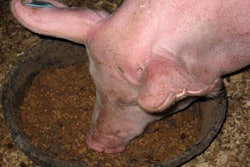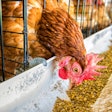
Attending a conference packed with over 1,500 delegates, all heavily involved in poultry nutrition, one cannot but approach such an event as the fulcrum of anything relevant in this industry. Even though I participated in the European Symposium on Poultry Nutrition (ESPN 2017) with an emphasis on educating myself, I noticed that many speakers focused — with much perception — on the future.
In other words, by looking at what is avant-garde research in universities and institutions across the world, it is possible to presage at least the immediate future. The following six trends are those that I strongly believe we will be discussing in great depth in the years to come.
1. Epigenetics and nutrition
Genetics is the science that studies the fusion of parental DNA, whereas epigenetics is a new branch that investigates how environmental stress factors become imprinted into DNA and affect its expression. This, according to Dr. Ferket from North Carolina State University in the United States, and Dr. Haron from the Hebrew University of Jerusalem in Israel, can explain why stress factors applied during incubation on eggs can lead to broilers that are more resistant to heat stress. In fact, such traits can pass down to the next two generations, at least. Similar adaptive conditioning of offspring can be affected by different nutrition stress factors applied to breeders. Thus, how we feed (including in ovo feeding) and manage breeders and their eggs can have a tremendous impact on progeny.
2. In ovo nutrition
Injecting eggs during incubation with a solution destined to augment the performance of hatched chicks is an innovative technique that counts almost 20 years of research and experience. Its importance will continue to increase because, according to Dr. Ferket, the more we reduce days-to-market in broilers, the greater impact is accorded to the incubation period (the latter being of a fixed term). In ovo nutrition can be considered as revolutionary as the development of premixes in feeding animals because, like with premixes, the in ovo solution provides nutrients and other bio-active compounds that enhance those already present in the egg. Such nutrients range from carbohydrates to amino acids, vitamins and minerals, whereas probiotics and compounds like butyric acid or even IGF-1 have also been tested with promising results. What keeps this technique becoming mainstream is logistics and, of course, a clear-cut understanding of the process and its benefits.
3. Chemosensory regulation of nutrient intake
Birds are considered less efficient in taste sensing compared to mammals. But, according to Dr. Roura from the University of Queensland in Australia, this notion is rather outdated. Indeed, the number of tastebuds in the oral cavity is not lower per unit of volume compared to mammals, whereas an extensive chemosensing system exists in birds that regulates nutrient intake. Currently, we have very limited understanding of how birds use their sensory apparatus to control nutrient and feed intake. A greater understanding of this relationship can help us provide nutrients in correct amounts that can improve flock uniformity in broilers and feather pecking in layers. This can be achieved with a better balance between individual needs and taste perceptions to flock requirements for productivity.
4. Gut microbial signaling and animal health
Although the gut contains more bacteria than cells in the body of a bird, according to Dr. van Immerseel from Ghent University in Belgium, it is those bacteria attached to the mucosa barrier that appear to be of most interest when it comes to microbial signals towards their host. One such example is the butyric acid producing bacteria. These are being fed by xylan breakdown products (such as through the action of feed enzymes or those produced by other microbes in the gut) releasing butyric acid. This simple fermentation acid is then absorbed by the intestinal epithelial cells reducing inflammation, increasing epithelial cell proliferation and transepithelial resistance — all leading to increased gut health. In addition, butyric acid acting as a signal molecule reduces the virulence of Salmonella. Other compounds are likely to offer similar beneficial results, and it is only now that we start to learn how to adjust feed composition to modulate gut microflora towards a healthier gut-microbial interaction.
5. Feed enzymes against 130 kg of fiber
Every metric ton of poultry feed contains about 130 kg of “fiber” — material that otherwise cannot be used by birds to derive energy and nutrients. Out of this significant waste, xylans comprise about 50 to 70 percent. Thus, according to Dr. Choct from the University of New England in Australia, this remains the target of NSP enzymes for the foreseeable future. The remaining indigestible fibers are mostly cellulose, pectins and lignin, all of which are hard to break down during the short transit time in intensively fed birds. It appears that the major challenges in xylanase technology are characterizing the over 2,000 xylanases available, understanding the variability of xylans in common cereals and matching the enzyme with its substrate. Even though xylanases are currently used to reduce viscosity in the gut, it is possible to use other xylanases that release interesting products that could act as probiotics. Here it is interesting to note that the use of xylo-oligosaccharides has been connected to beneficial effects on gut butyrate-producing bacteria.
6. Modelling phosphorus requirements in broilers
Phosphorus will remain a topic in vogue for years to come, not only because excess phosphorus has been characterized as a priority environmental hazard, but also because inorganic phosphorus sources will remain richly priced, whereas enzyme manufacturers continue to invest on phytase. Thus, in an industry where pennies on the dollar are left for profit, assessing correct phosphorus requirements is deemed paramount for the third most expensive nutrient. A factorial approach attempted by French researchers, Drs. Khaksar, Meda and Narcy at INRA in France, revealed the following four aspects regarding available phosphorus:
- Maintenance requirements remain below 10 percent of total for the whole life of broilers
- Available phosphorus requirements are highly related to body weight and weight gain
- Requirements remain constant during the first 30 days post-hatch, decreasing afterwards
- Requirements of available phosphorus range from 0.07 to 0.48 grams/day from hatch until market age
These data were validated with data from experiments conducted between the years 2012 and 2015.
The above are but a brief outline of those topics that I considered the most important, or rather the most innovative. The conference included 19 such lectures, so it is worthy acquiring the proceedings.
















